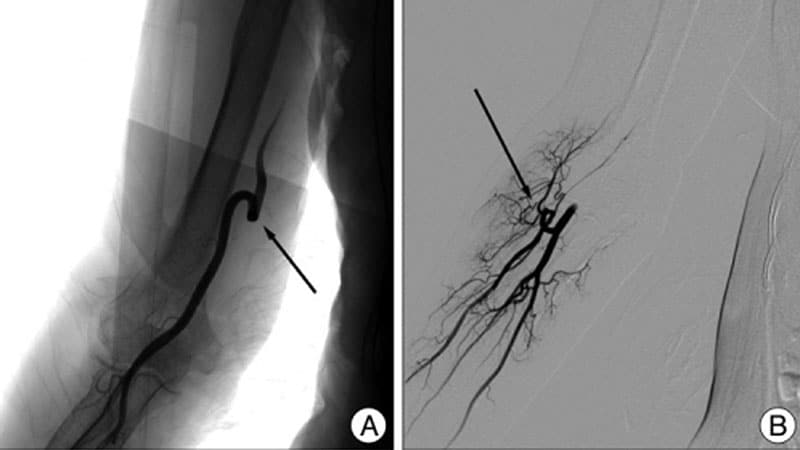[ad_1]
A transradial approach (TRA) for cerebral angiography was less effective than the transfemoral route in achieving an accurate diagnostic success rate.
Study investigator, Wei Ni, MD, Huashan Hospital, Fudan University, Shanghai, China, attributed the disappointing results to current equipment limitations in the current equipment transradial access.
“Although we did not impose any restrictions on the materials or techniques used for TRA angiography, allowing operators to choose from all available catheters, guidewires, and other devices, our experience in practice showed that the current equipment still has limitations. This highlights the need for future development of new materials and devices to improve outcomes,” he said.
Ni presented the results of the transradial versus transfemoral arterial access for cerebral angiography (TRACE) trial on February 5 at the International Stroke Conference 2025.
Noninferiority Primary Endpoint
Ni explained that diagnostic cerebral angiography has traditionally involved trans femoral access which involves inserting the catheter into the femoral artery in the groin area.
However, this approach has been associated with complications, including pain, discomfort, retroperitoneal hemorrhage, pulmonary embolism, and increased hospital admissions.
Transradial access involves inserting the catheter into the radial artery in the wrist. It is a newer approach that offers several potential advantages, including a lower risk for puncture-related complications, but it comes with its own challenges including a longer learning curve and fewer equipment options.
Ni noted that while several large trials in cardiology have established radial access as the first-line strategy, robust evidence from high-quality trials is still lacking in cerebrovascular intervention to confirm the safety and efficacy of the TRA.
The TRACE trial was an investigator-initiated, open-label study, which included 858 patients scheduled for diagnostic cerebral angiography across 13 centers in China. Participants were randomly assigned to angiography with either the femoral or radial approach.
The aim of the study was to show noninferiority of the radial approach to the femoral approach in terms of feasibility and diagnostic accuracy.
The primary outcome was the success rate of diagnostic cerebral angiography, defined as successfully selecting the supra-aortic vessels and obtaining angiographic images of sufficient quality to make the basic diagnosis.
This occurred in 91.0% in the radial group and 95.8% for the femoral approach, a result that did not fulfil the noninferiority criteria.
“That means that transradial angiography was inferior to the transfemoral approach in our study,” said Ni.
Lower Diagnostic Success Rate
A secondary endpoint was the rate of accurate diagnosis, defined as the successful selection of the target vessel by the catheter, allowing for precise blood flow assessment or detailed visualization of the disorder.
The transradial group achieved an accurate diagnostic success rate of 78.9%, which was significantly lower than that of the transfemoral group.
Other secondary results included longer angiography and fluoroscopy times but shorter bedrest duration and lower visual analogue scale scores, an indicator of less pain, with the radial route.
Ni pointed out that in the transradial group, 16 cases failed at the stage of sheath placement or failed at advancing catheter caused by vasospasm.
“This suggests that radial puncture and its related vasospasm is a major challenge for cerebral angiography via the transradial route,” he said.
“Radial puncture remains a major obstacle for neuroradiologists performing radial angiography and developing more efficient transradial angiography devices is essential for enhancing the success rate,” he added.
‘A Clearly Negative Trial’
Commenting on the study for Medscape Medical News, Craig Anderson, MD , The George Institute for Global Health, Sydney, Australia, said that ultimately this was “a clearly negative trial with the radial approach not showing such a good result as the conventional femoral approach.
“The ability to access the radial artery appeared to be more difficult. The radial artery is smaller than the femoral, so radial access requires more skill.”
“At the present time,” Anderson added, “we should not be using a radial approach for routine cerebral angiography. It should be reserved for specific cases with certain anatomical features. Perhaps interventionalists need more practice in this technique, or maybe, different, smaller catheters need to be developed.”
The TRACE trial was an investigator-initiated study. Ni reported no relevant disclosures.
[ad_2]
Source link : https://www.medscape.com/viewarticle/radial-access-problematic-cerebral-angiography-2025a10003ry?src=rss
Author :
Publish date : 2025-02-13 11:04:21
Copyright for syndicated content belongs to the linked Source.
